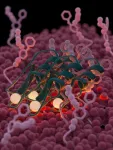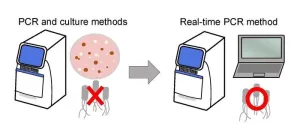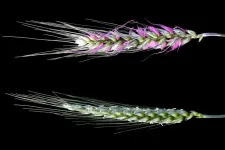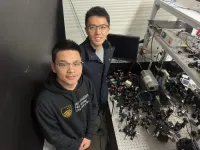(Press-News.org) A small antibiotic called plectasin uses an innovative mechanism to kill bacteria. By assembling into large structures, plectasin latches onto its target on the bacterial cell surface comparable to how both sides of Velcro form a bond. A research team, led by structural biologist Markus Weingarth and biochemist Eefjan Breukink at Utrecht University, mapped how the Velcro-structure is formed. Their discovery, published in the scientific journal Nature Microbiology, unveils a new approach that could have broad implications for the development of antibiotics to combat antimicrobial resistance.
The research team delved into the workings of plectasin, an antibiotic derived from the fungus Pseudoplectania nigrella. The team employed advanced biophysical techniques, including solid-state NMR and, in collaboration with Wouter Roos from Groningen, atomic force microscopy.
Traditionally, antibiotics function by targeting specific molecules within bacterial cells. However, the mechanism behind plectasin’s action was not fully understood until now. Previous studies suggested a conventional model where plectasin binds to a molecule called Lipid II, crucial for bacterial cell wall synthesis, akin to a key fitting into a lock.
The new study reveals a more intricate process. Plectasin doesn’t just act like a key in a lock; instead, it forms dense structures on bacterial membranes containing Lipid II. These supramolecular complexes trap their target Lipid II, preventing it from escaping. Even if one Lipid II breaks free from plectasin, it remains contained within the Velcro-structure, unable to escape.
Weingarth compares this structure to Velcro, where plectasin forms the microscopic hooks that attach to bacterial ‘loops’. In normal Velcro, if one of the loops breaks free from its hook, it is still trapped by the entire structures. The same goes for bacteria trapped in the plectasin superstructure: they can break free from the plectasin’s binding, but stay trapped in the superstructure. This prevents the bacteria to escape and cause further infections.
Moreover, the researchers found that the presence of calcium ions further enhances plectasin's antibacterial activity. These ions coordinate with specific regions of plectasin, causing structural changes that significantly improve the antibacterial effectiveness. That ions play a critical part the action of plectasin was discovered by PhD students Shehrazade Miranda Jekhmane and Maik Derks, co-first authors of the study. They realized that plectasin samples had a peculiar colour, which hinted at the presence of ions.
Markus Weingarth, the lead author of the study, expects this finding could open new avenues for developing superior antibiotics. “Plectasin is presumably not the ideal antibiotic candidate due safety concerns. However, in our study, we show that the ‘Velcro-mechanism’ appears widely used among antibiotics, which was thus far ignored. Future drug design efforts hence not only need to focus on how to bind targets, but also how drugs can self-assemble efficiently. Thereby, our study closes a major knowledge gap which could have broad implications for the design of better drugs to combat the growing threat of antimicrobial resistance.”
END
Antibiotic ‘Velcro’ gives bacteria a sticky situation
2024-05-23
ELSE PRESS RELEASES FROM THIS DATE:
City of Hope researchers to present investigational treatments for colorectal, kidney and blood cancers at 2024 American Society of Clinical Oncology (ASCO) Annual Meeting
2024-05-23
LOS ANGELES — World-renowned physicians and researchers from City of Hope®, one of the largest cancer research and treatment organizations in the United States, will present new data and offer expert perspectives on leading-edge cancer research and treatments in development at the 2024 ASCO Annual Meeting, which will take place in Chicago from May 31 to June 4. Highlights include the following:
2024 Best of ASCO® program: New data on mismatched unrelated donor peripheral blood stem cell transplantation
Late-breaking data on the phase 3 CodeBreaK 300 trial
Glofitamab monotherapy for patients ...
Bigger is better: male proboscis monkeys’ enhanced noses evolved to attract mates
2024-05-23
When it comes to the animal kingdom, bigger is better. Well, at least for proboscis monkeys, famously known for their long, large and droopy noses.
Researchers from The Australian National University (ANU) have provided a world-first explanation for why male proboscis monkeys have larger and “enhanced” nasal structures.
The researchers examined the bony nasal cavity inside the skulls of proboscis monkeys and found their large noses are more than just an eye sore and in fact offer several major benefits, especially when ...
Early access to first-seizure clinics, subsequent outcomes, and factors associated with attendance
2024-05-23
About The Study: The results of this cohort study suggest that first-seizure clinic (FSC) attendance, particularly early attendance, was associated with reduced rates of subsequent hospital utilization. This knowledge may support adequately resourcing FSCs to improve equitable, timely access. Future study directions include assessing interventions that may support FSC attendance for at-risk groups.
Corresponding Author: To contact the corresponding author, Emma Foster, M.B.B.S.(Hons), Ph.D., email emma.foster@monash.edu.
To access the embargoed study: Visit our For The Media website at this link https://media.jamanetwork.com/
(doi:10.1001/jamaneurol.2024.1187)
Editor’s ...
How stores use TikTok to sell e-cigarettes to children
2024-05-23
A new paper in Nicotine and Tobacco Research, published by Oxford University Press, shows that advertising and sales of vaping products is common on TikTok, the video sharing platform popular among teenagers. Users pushing these items often use hashtags like #puffbundles to disguise vaping products by including things like lip gloss and candy in the packages for sale.
Despite smoking rates reaching an all-time low in the United States, public health professionals are concerned about adolescent use of electronic cigarettes. In 2023 some 4.7 million (17%) middle school and high school students ...
Mistaken identity cleared up of foodborne pathogen causing severe symptoms in children
2024-05-23
The prevalence of pathogenic E. coli has meant the frequent misidentification of a similar bacterium of the Escherichia genus. E. albertii is an emerging zoonotic foodborne pathogen, first isolated in Bangladesh in 1991. Large-scale outbreaks of food poisoning caused by E. albertii have since been reported especially in Japan, causing severe symptoms in both children and adults.
In the hopes of establishing a diagnostic method, a joint research group led by Professor Shinji Yamasaki and Dr. Sharda Prasad Awasthi, a specially appointed ...
Approximately one in nine U.S. children diagnosed with ADHD, as new national study highlights an “ever-expanding” public health concern
2024-05-23
An exploration into the national U.S. dataset on children ever diagnosed with ADHD has revealed an “ongoing and ever-expanding” public health issue.
Findings published in the peer-reviewed Journal of Clinical Child & Adolescent Psychology uncover that approximately one million more children, aged 3-17, had received an ADHD diagnosis in 2022 than in 2016.
The paper reveals around one in nine children have ever received an ADHD diagnosis – 11.4%, ...
Survey: Parents of young athletes value health benefits of sports, but experts emphasize watching for signs of stress, burnout
2024-05-23
COLUMBUS, Ohio (May 23, 2024) — Positive sports experiences can be a game changer for kids, with physical, social, emotional and mental health benefits that last a lifetime, according to a new survey from The Kids Mental Health Foundation. However, youth mental health advocates with The Kids Mental Health Foundation stress the importance of ongoing conversations with young athletes about how their sports are impacting their confidence, self-esteem and happiness, whether it’s positive or negative.
The national survey conducted by Ipsos on behalf of The Kids Mental Health Foundation finds parents overwhelmingly ...
Gene could unlock big wheat yields for a growing population
2024-05-23
A study from the University of Adelaide has discovered molecular pathways regulated by a gene traditionally used to control wheat-flowering behaviour could be altered to achieve greater yields.
The gene is called Photoperiod-1 (Ppd-1) and it is used regularly by breeders to ensure wheat crops flower and set grain earlier in the season, avoiding the harsh conditions of summer. However, there are known drawbacks.
“While this variation benefits wheat productivity by aligning pollination and grain development with more favourable environmental conditions, it also penalises yield by reducing the number of ...
Quantum photonic technologies set to be more reliable with new interferometer.
2024-05-23
An increasing number of emerging quantum applications operate using optical technologies. Essentially, photons carry information at the speed of light and over long distances, making them good candidates for fast and secure communications and quantum computing. Many of these applications require photons that are identical (indistinguishable). When the photons are not identical, it can lead to errors in the data and quantum technologies become less reliable.
Currently, quantum photon sources are regularly taken offline to be tested and adjusted using ...
Future climate impacts put whale diet at risk
2024-05-23
A new study led by Griffith University predicts that future climate change impacts could disrupt the krill-heavy diet that humpback whales in the southern hemisphere consume.
Dr Jasmin Groß, who conducted the study as a PhD candidate at Griffith’s Centre for Planetary Health and Food Security analysed fatty acids and stable isotopes from blubber and skin samples of five different humpback whale populations around the southern hemisphere.
These levels were then compared to those of their primary prey item, Antarctic krill.
The team found that although there were distinct differences in the biochemical profiles, the diet of all tested ...







